Organizational Management: Task Solution and Analysis Report
VerifiedAdded on 2022/08/08
|5
|960
|45
Homework Assignment
AI Summary
This assignment solution addresses several key aspects of organizational management, including the management and storage of operational performance records, the role of operational plans in achieving organizational objectives, and budgeting processes. It also explores strategies for improving resource usage and reducing waste, outlines relevant legislation and regulations, and details organizational policies and procedures related to operational plans and intellectual property protection. Furthermore, the solution covers risk management, emphasizing the establishment of a risk context, stakeholder identification, and the review of current risk management processes. The document also includes a discussion on developing performance plans, ensuring alignment with organizational values and ethical considerations.
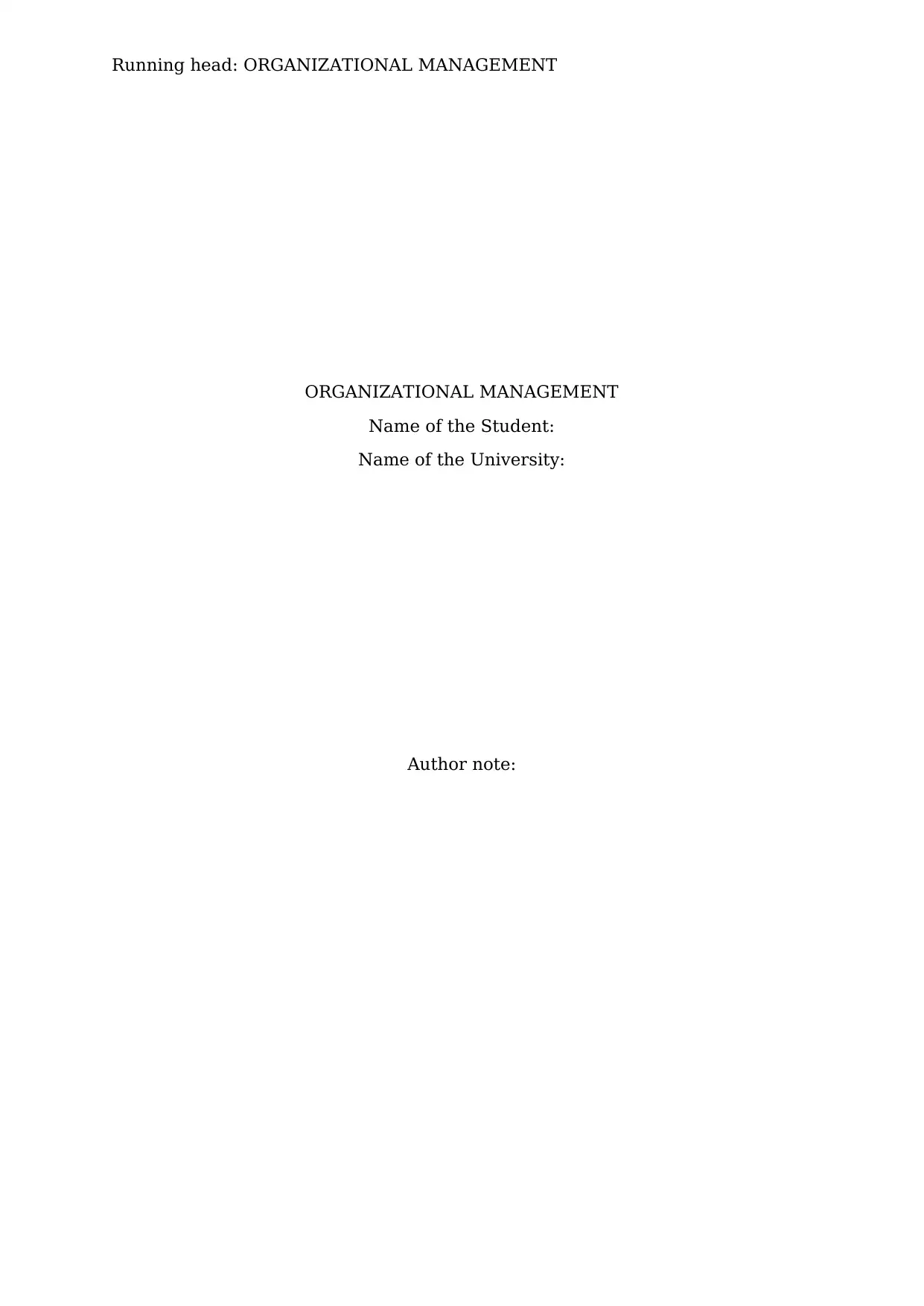
Running head: ORGANIZATIONAL MANAGEMENT
ORGANIZATIONAL MANAGEMENT
Name of the Student:
Name of the University:
Author note:
ORGANIZATIONAL MANAGEMENT
Name of the Student:
Name of the University:
Author note:
Paraphrase This Document
Need a fresh take? Get an instant paraphrase of this document with our AI Paraphraser
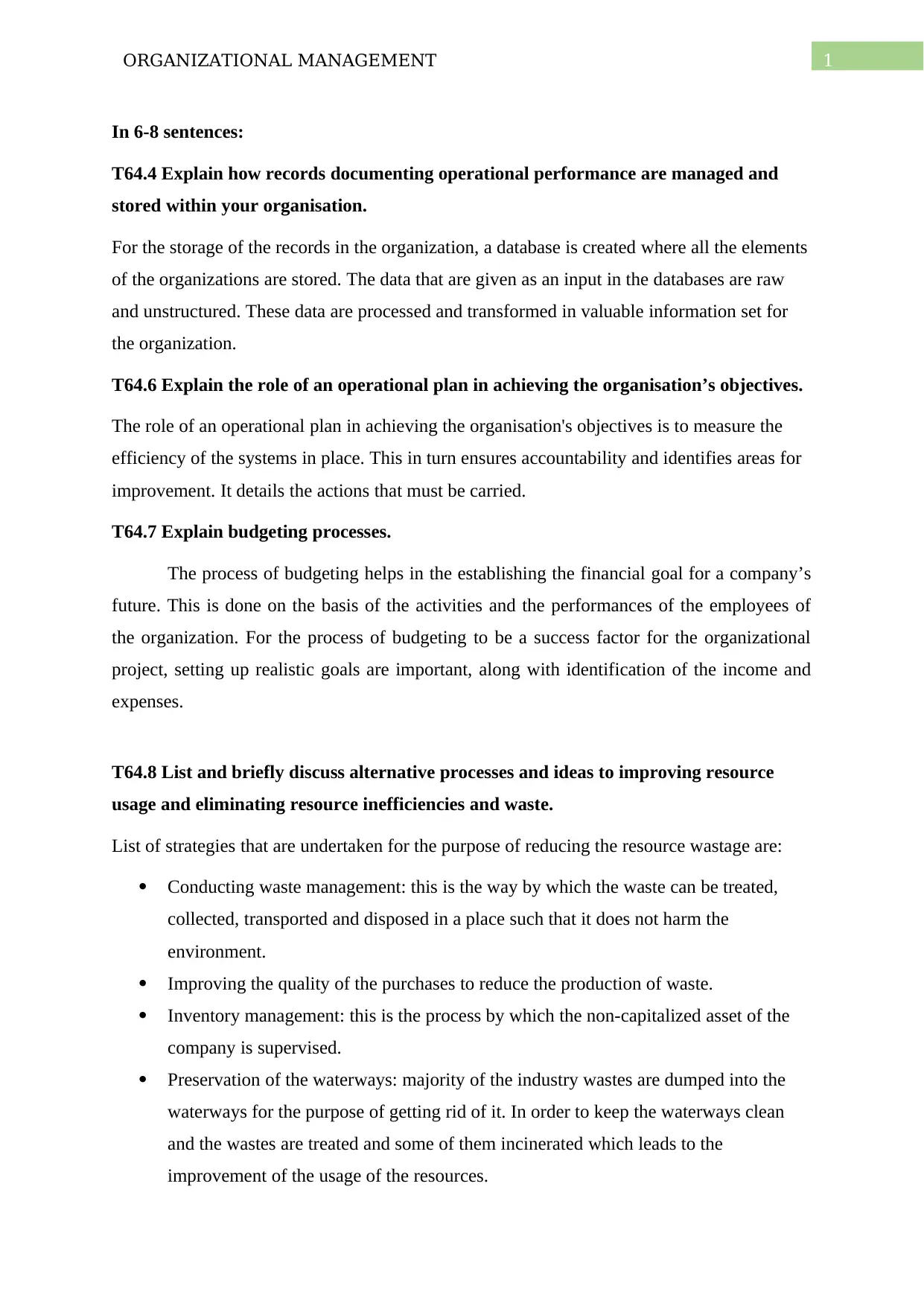
1ORGANIZATIONAL MANAGEMENT
In 6-8 sentences:
T64.4 Explain how records documenting operational performance are managed and
stored within your organisation.
For the storage of the records in the organization, a database is created where all the elements
of the organizations are stored. The data that are given as an input in the databases are raw
and unstructured. These data are processed and transformed in valuable information set for
the organization.
T64.6 Explain the role of an operational plan in achieving the organisation’s objectives.
The role of an operational plan in achieving the organisation's objectives is to measure the
efficiency of the systems in place. This in turn ensures accountability and identifies areas for
improvement. It details the actions that must be carried.
T64.7 Explain budgeting processes.
The process of budgeting helps in the establishing the financial goal for a company’s
future. This is done on the basis of the activities and the performances of the employees of
the organization. For the process of budgeting to be a success factor for the organizational
project, setting up realistic goals are important, along with identification of the income and
expenses.
T64.8 List and briefly discuss alternative processes and ideas to improving resource
usage and eliminating resource inefficiencies and waste.
List of strategies that are undertaken for the purpose of reducing the resource wastage are:
Conducting waste management: this is the way by which the waste can be treated,
collected, transported and disposed in a place such that it does not harm the
environment.
Improving the quality of the purchases to reduce the production of waste.
Inventory management: this is the process by which the non-capitalized asset of the
company is supervised.
Preservation of the waterways: majority of the industry wastes are dumped into the
waterways for the purpose of getting rid of it. In order to keep the waterways clean
and the wastes are treated and some of them incinerated which leads to the
improvement of the usage of the resources.
In 6-8 sentences:
T64.4 Explain how records documenting operational performance are managed and
stored within your organisation.
For the storage of the records in the organization, a database is created where all the elements
of the organizations are stored. The data that are given as an input in the databases are raw
and unstructured. These data are processed and transformed in valuable information set for
the organization.
T64.6 Explain the role of an operational plan in achieving the organisation’s objectives.
The role of an operational plan in achieving the organisation's objectives is to measure the
efficiency of the systems in place. This in turn ensures accountability and identifies areas for
improvement. It details the actions that must be carried.
T64.7 Explain budgeting processes.
The process of budgeting helps in the establishing the financial goal for a company’s
future. This is done on the basis of the activities and the performances of the employees of
the organization. For the process of budgeting to be a success factor for the organizational
project, setting up realistic goals are important, along with identification of the income and
expenses.
T64.8 List and briefly discuss alternative processes and ideas to improving resource
usage and eliminating resource inefficiencies and waste.
List of strategies that are undertaken for the purpose of reducing the resource wastage are:
Conducting waste management: this is the way by which the waste can be treated,
collected, transported and disposed in a place such that it does not harm the
environment.
Improving the quality of the purchases to reduce the production of waste.
Inventory management: this is the process by which the non-capitalized asset of the
company is supervised.
Preservation of the waterways: majority of the industry wastes are dumped into the
waterways for the purpose of getting rid of it. In order to keep the waterways clean
and the wastes are treated and some of them incinerated which leads to the
improvement of the usage of the resources.
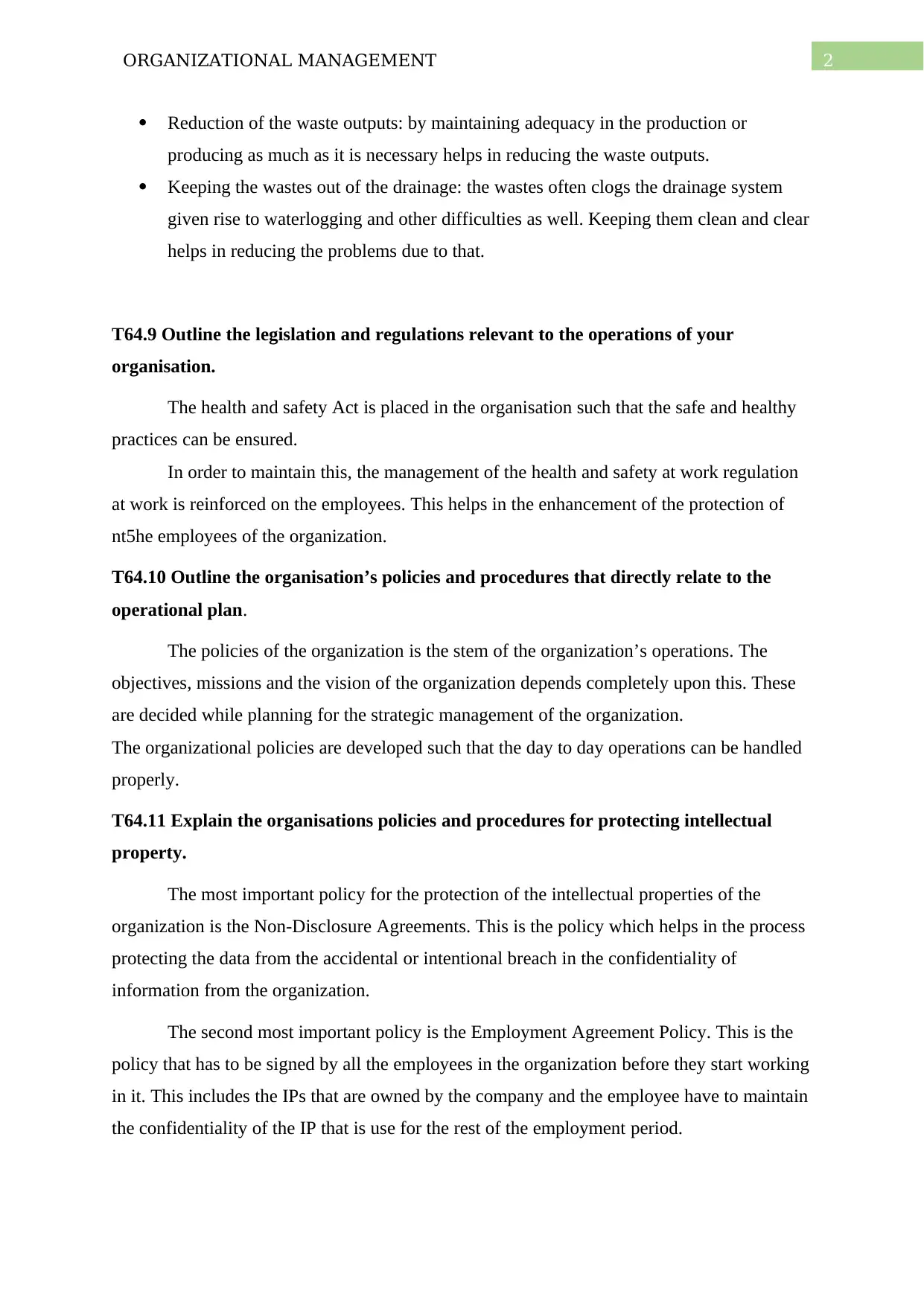
2ORGANIZATIONAL MANAGEMENT
Reduction of the waste outputs: by maintaining adequacy in the production or
producing as much as it is necessary helps in reducing the waste outputs.
Keeping the wastes out of the drainage: the wastes often clogs the drainage system
given rise to waterlogging and other difficulties as well. Keeping them clean and clear
helps in reducing the problems due to that.
T64.9 Outline the legislation and regulations relevant to the operations of your
organisation.
The health and safety Act is placed in the organisation such that the safe and healthy
practices can be ensured.
In order to maintain this, the management of the health and safety at work regulation
at work is reinforced on the employees. This helps in the enhancement of the protection of
nt5he employees of the organization.
T64.10 Outline the organisation’s policies and procedures that directly relate to the
operational plan.
The policies of the organization is the stem of the organization’s operations. The
objectives, missions and the vision of the organization depends completely upon this. These
are decided while planning for the strategic management of the organization.
The organizational policies are developed such that the day to day operations can be handled
properly.
T64.11 Explain the organisations policies and procedures for protecting intellectual
property.
The most important policy for the protection of the intellectual properties of the
organization is the Non-Disclosure Agreements. This is the policy which helps in the process
protecting the data from the accidental or intentional breach in the confidentiality of
information from the organization.
The second most important policy is the Employment Agreement Policy. This is the
policy that has to be signed by all the employees in the organization before they start working
in it. This includes the IPs that are owned by the company and the employee have to maintain
the confidentiality of the IP that is use for the rest of the employment period.
Reduction of the waste outputs: by maintaining adequacy in the production or
producing as much as it is necessary helps in reducing the waste outputs.
Keeping the wastes out of the drainage: the wastes often clogs the drainage system
given rise to waterlogging and other difficulties as well. Keeping them clean and clear
helps in reducing the problems due to that.
T64.9 Outline the legislation and regulations relevant to the operations of your
organisation.
The health and safety Act is placed in the organisation such that the safe and healthy
practices can be ensured.
In order to maintain this, the management of the health and safety at work regulation
at work is reinforced on the employees. This helps in the enhancement of the protection of
nt5he employees of the organization.
T64.10 Outline the organisation’s policies and procedures that directly relate to the
operational plan.
The policies of the organization is the stem of the organization’s operations. The
objectives, missions and the vision of the organization depends completely upon this. These
are decided while planning for the strategic management of the organization.
The organizational policies are developed such that the day to day operations can be handled
properly.
T64.11 Explain the organisations policies and procedures for protecting intellectual
property.
The most important policy for the protection of the intellectual properties of the
organization is the Non-Disclosure Agreements. This is the policy which helps in the process
protecting the data from the accidental or intentional breach in the confidentiality of
information from the organization.
The second most important policy is the Employment Agreement Policy. This is the
policy that has to be signed by all the employees in the organization before they start working
in it. This includes the IPs that are owned by the company and the employee have to maintain
the confidentiality of the IP that is use for the rest of the employment period.
⊘ This is a preview!⊘
Do you want full access?
Subscribe today to unlock all pages.

Trusted by 1+ million students worldwide
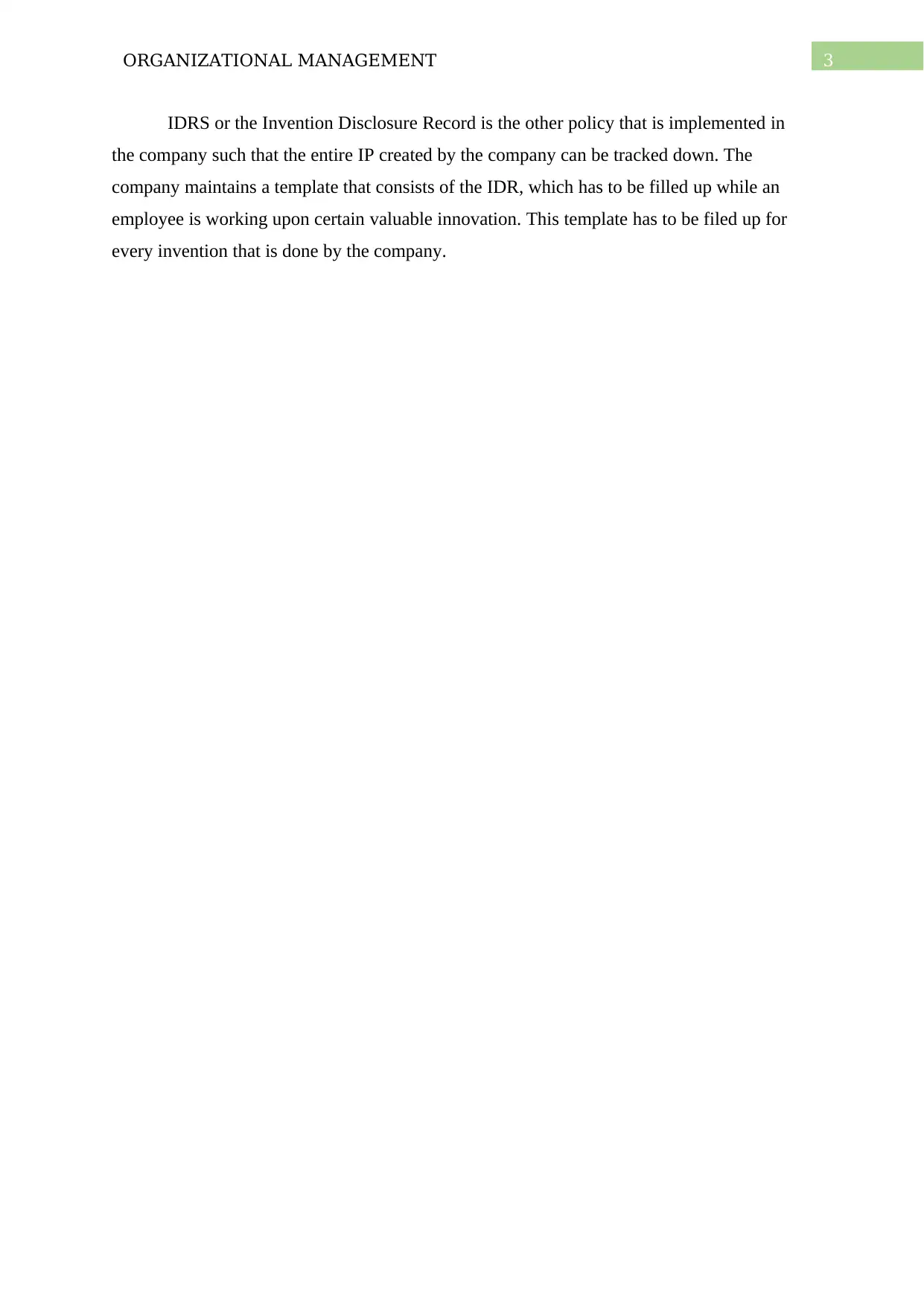
3ORGANIZATIONAL MANAGEMENT
IDRS or the Invention Disclosure Record is the other policy that is implemented in
the company such that the entire IP created by the company can be tracked down. The
company maintains a template that consists of the IDR, which has to be filled up while an
employee is working upon certain valuable innovation. This template has to be filed up for
every invention that is done by the company.
IDRS or the Invention Disclosure Record is the other policy that is implemented in
the company such that the entire IP created by the company can be tracked down. The
company maintains a template that consists of the IDR, which has to be filled up while an
employee is working upon certain valuable innovation. This template has to be filed up for
every invention that is done by the company.
Paraphrase This Document
Need a fresh take? Get an instant paraphrase of this document with our AI Paraphraser
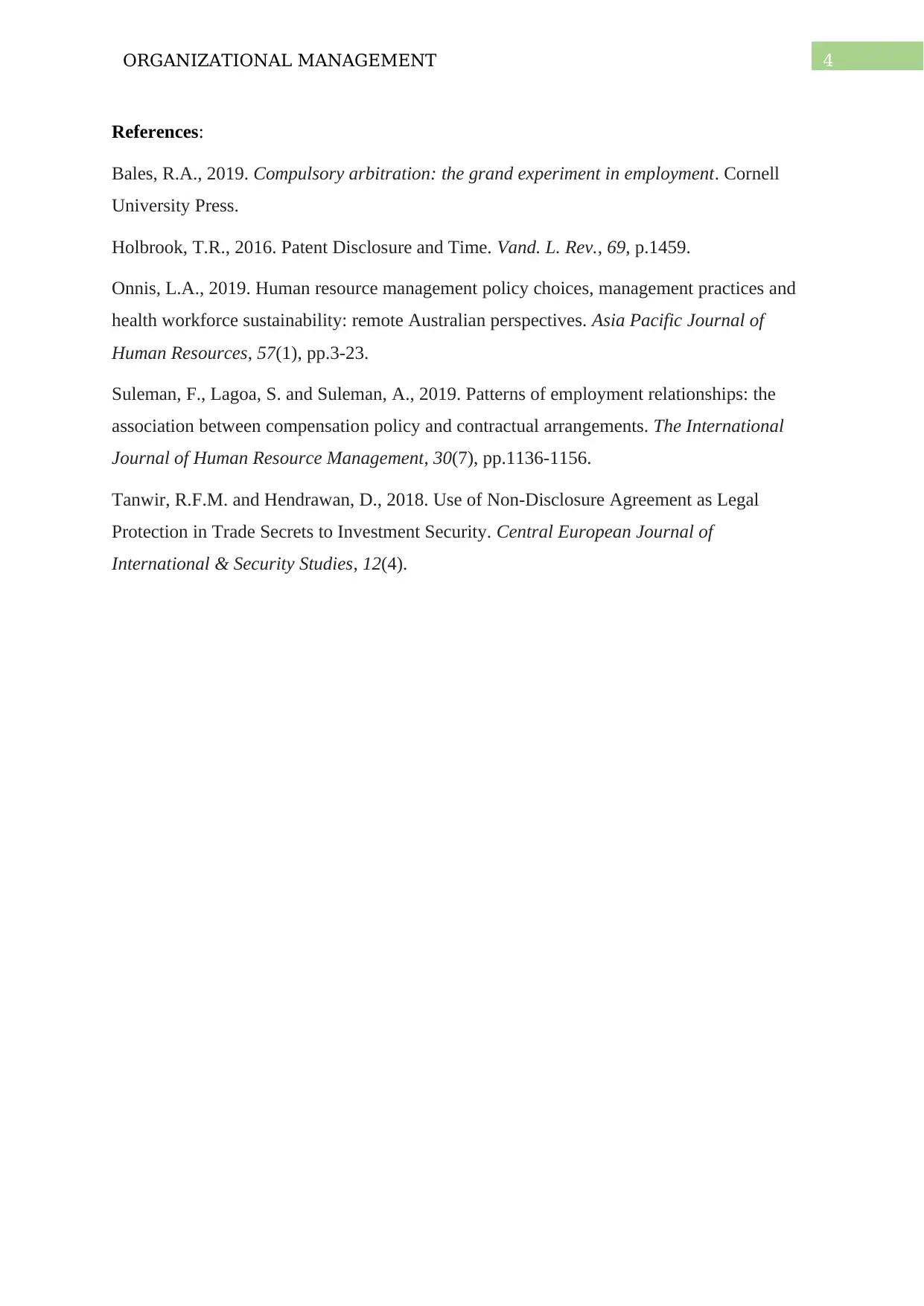
4ORGANIZATIONAL MANAGEMENT
References:
Bales, R.A., 2019. Compulsory arbitration: the grand experiment in employment. Cornell
University Press.
Holbrook, T.R., 2016. Patent Disclosure and Time. Vand. L. Rev., 69, p.1459.
Onnis, L.A., 2019. Human resource management policy choices, management practices and
health workforce sustainability: remote Australian perspectives. Asia Pacific Journal of
Human Resources, 57(1), pp.3-23.
Suleman, F., Lagoa, S. and Suleman, A., 2019. Patterns of employment relationships: the
association between compensation policy and contractual arrangements. The International
Journal of Human Resource Management, 30(7), pp.1136-1156.
Tanwir, R.F.M. and Hendrawan, D., 2018. Use of Non-Disclosure Agreement as Legal
Protection in Trade Secrets to Investment Security. Central European Journal of
International & Security Studies, 12(4).
References:
Bales, R.A., 2019. Compulsory arbitration: the grand experiment in employment. Cornell
University Press.
Holbrook, T.R., 2016. Patent Disclosure and Time. Vand. L. Rev., 69, p.1459.
Onnis, L.A., 2019. Human resource management policy choices, management practices and
health workforce sustainability: remote Australian perspectives. Asia Pacific Journal of
Human Resources, 57(1), pp.3-23.
Suleman, F., Lagoa, S. and Suleman, A., 2019. Patterns of employment relationships: the
association between compensation policy and contractual arrangements. The International
Journal of Human Resource Management, 30(7), pp.1136-1156.
Tanwir, R.F.M. and Hendrawan, D., 2018. Use of Non-Disclosure Agreement as Legal
Protection in Trade Secrets to Investment Security. Central European Journal of
International & Security Studies, 12(4).
1 out of 5
Related Documents
Your All-in-One AI-Powered Toolkit for Academic Success.
+13062052269
info@desklib.com
Available 24*7 on WhatsApp / Email
![[object Object]](/_next/static/media/star-bottom.7253800d.svg)
Unlock your academic potential
Copyright © 2020–2025 A2Z Services. All Rights Reserved. Developed and managed by ZUCOL.





